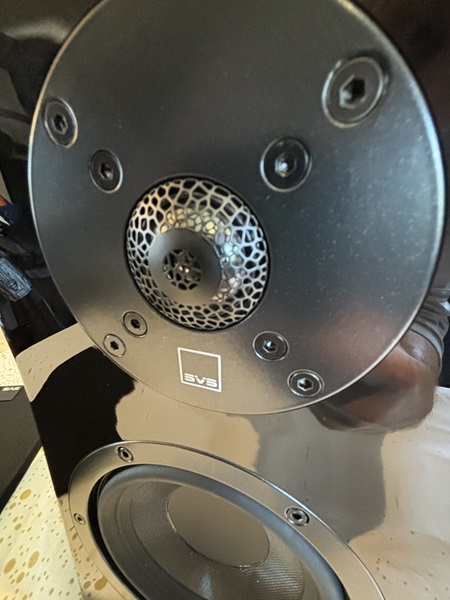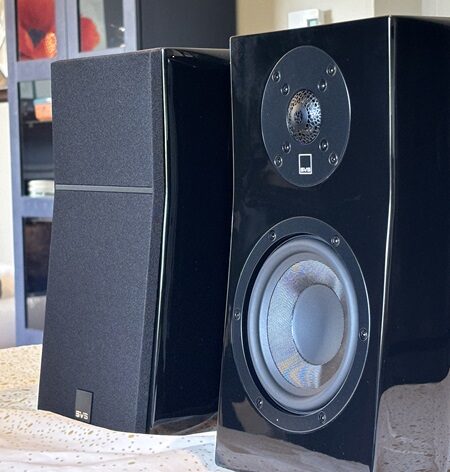SVS Ultra Evolution Nano – Big Sound From A Small Speaker
I admit it, in the ’90s I only wanted tower speakers. However, after some shock therapy and a good dose of common sense, I realized how wrong I was. Here is the fact most people don’t understand. The $1000(ish)/pair bookshelf speaker is where it’s at. You often get much of the technology from a brand’s higher-end speakers. Plus, they tend to be a HUGE step up from their entry line. Well, I got my hands on the SVS Ultra Evolution Nano! Priced at $449/per or $898/per pair, the SVS Ultra Evolution Nano provides a big sound from a small speaker. Let’s discuss.
Specs Of The SVS Ultra Evolution Nano
| Frequency Response | 44Hz to 40kHz (+/-3 dB) |
| Nominal impedance | 6 ohms |
| Sensitivity | 85dB (2.83V @ 1 meter full-space, 300Hz – 3kHz) |
| Recommended amplifier power | 20 – 150 watts |
| Finish Options | Piano gloss black, piano gloss white, real black oak veneer |
| Overall Dimensions | 12.36” (H) x 7.48” (W) x 9.57” (D) |
| Driver Specs | 1″ Diamond coated tweeter, 5.25″ Woofer |
| Crossover | 1.9 kHz, 2-way crossover with premium-grade capacitors, inductors, resistors, and heavy-trace printed circuit board |
| Cabinet | Time-aligned cabinet geometry |
| Chamfered front baffle and flush-mounted drivers | |
| Extra-thick 1” (25mm) driver baffle |
Build Quality Of The SVS Ultra Evolution Nano
I’ve said it before, but looks are wholly subjective regarding speakers. Some manufacturers eschew fit and finish for pure performance. However, SVS has combined the two with the SVS Ultra Evolution Nano. My SVS Ultra Evolution Nanos came in gloss black and the finish is flawless. I didn’t realize how good the gloss black finish was until I tried to get photos without me or objects reflected on the speakers.


The new SVS Ultra Evolution Nano features an angled design that supports their time-aligned cabinet geometry. I am a fan of this new design. Most speakers are just boring black boxes. The SVS Ultra Evolution Nano looks good on the stand and punches well above its sub-$1000 price tag in the design department. Well done, SVS.

Continuing the design thread, the SVS Ultra Evolution line sports an “FEA-optimized Organic Cell Lattice Diffuser.” In English, the tweeter sits behind a metal lattice designed to reduce distortion and create a more cohesive and less shrill high-end. Plus, your tweeter dome gets protected from little fingers that love to poke things. Win-win!

Lastly, as one might expect from the flagship line of speakers, there are many little refinements. Let’s start with the 1.6″ port on the back. The port is nicely flared and sits 3/4 of the way down the speaker. The SVS Ultra Evolution Nano also sports a pair of gold-plated 5-way binding posts to keep your speaker wires firmly in place. The last touch I want to point out is the magnetic grills. The lack of speaker grill posts means these speakers look sexy and sleek with their grills off!
Test Gear And The Room
Powering the SVS Ultra Evolution Nano is my Onkyo TX-NR7100. The 7100 will push 100W (2-ch driven), and I sit about six feet away from them, so power won’t be an issue. The SVS Ultra Evolution Nano’s are 85dB sensitive @ 6 ohms. That’s pretty average, so don’t go out and buy an external amp for the Nanos. If you are not putting them in a massive room, a typical A/V receiver has more than enough power.
A pair of SVS PB-1000 Pro subwoofers set up with Rob H’s 12-Step Guide to Setting Up Dual Subwoofers supports the low end. However, I did spend a fair amount of time listening with just the SVS Ultra Evolution Nano’s and no subs!


My room has acoustic panels, and I re-ran Dirac Live once I had the SVS Ultra Evolution Nanos properly positioned. The sweet spot was about 18″ off the wall with a toe-in to my main listening point. I want to mention that the SVS Ultra Evolution Nano’s have a generous sweet spot and wide dispersion, so the toe-in is pure habit.

What sources do you have? Yes! I love physical media. That means I have a turntable, a CD player, an MD player, and lossless music through my Apple TV 4K. No, I didn’t forget home theater! I will ensure that alongside music, I will give the SVS Ultra Evolution Nano a proper test with movies. To that end, I have Remux movies on NVIDIA Shield running Plex, and UHD on my Xbox. In my mind, there is no such thing as a “music-only” or “home theater-only” speaker. A good speaker should do everything well!

How Does the SVS Ultra Evolution Nanos Sound?
The first thing I did was run a sweep to test the specs of the SVS Ultra Evolution Nano speakers. Unsurprisingly, SVS was accurate and they do play down to 44 Hz with some authority. No, they don’t kick you in the chest like a pair of SVS PB-1000 Pro’s. But if you wanted ONLY a pair of speakers for a 2.0 system, I wouldn’t say no. Even without subwoofers, they handled music well, and I didn’t find them lacking.
I can also confirm that SVS is targeting an exceedingly neutral sound. There are no exaggerated highs or lows. Nor did I find they fell off a cliff sharply or had nulls. Smooth and steady is an apt description of the SVS Ultra Evolution Nanos. However, as stated, I have a well-treated room, set the Nanos up correctly and ran room correction. Placement is important kids!
I should point out that most of my listening experience is with neutral speakers. This familiarity means that my brain and ears won’t need much time (if any) to get accustomed to how the Nanos sound, right out of the box.
Music
As a music fan, I judge everything on my favorite collection of test tracks. If you follow my reviews, you know I listen to jazz, hip-hop, classical, and tracks that test stereo separation and panning. For new readers, we use music that we are very familiar with. This way we know what to expect and the brain doesn’t need to evaluate new songs.
The SVS Ultra Evolution Nano’s get surprisingly low for a 5.25″ woofer. I did all of my tests with and without my dual subwoofers. I was pleasantly surprised with how full the SVS Ultra Evolution Nano’s sounded without them. My old favorite, Take Five by the Dave Brubeck Quartet sounded great. I was expecting the drum solo to be anemic without the addition of a subwoofer. Granted, I am 6′ away from my left and right speakers, so I am not trying to fill a massive space with sound.

The one area where I am most critical of speaker design is high-end frequencies. I can suffer listener fatigue pretty quickly with a shrill speaker. SVS has designed all of their speakers to be neutral. This means no boosted frequencies, high or low. To test treble, I use classical music, specifically cello or violin. Adagio For Strings by Samuel Barber is my go-to, and there was no shrillness until I turned the SVS Nano’s well past reference volume. However, I am convinced that the shrillness is a product of my room, not the speakers. My room is too small to accommodate exceedingly loud volumes.
To test stereo separation, panning, and soundstage, I mixed alternative, folk, and rock music. Keith Don’t Go (Live) by Nils Lofgren is an excellent test of soundstage and imaging. The SVS Ultra Evolution Nanos nearly recreated the feel of a live concert. This is one case where I needed a subwoofer to supplement the low end. Panning and stereo separation were tested by Everything In Its Right Place by Radiohead. Panning and separation were exceptional, and overall I found the sound cohesive, with nothing distracting me.

Movies
Here is where the SVS Ultra Evolution Nano needs the support of a subwoofer. That is not a slight against the Nano’s. I have yet to find a tower speaker that can handle movie duty without the support of a good subwoofer, let alone a compact bookshelf. That said, with a good subwoofer, I didn’t find the SVS Ultra Evolution Nano’s lacking in any way. In my small room (21′ x 13′), and at 6′ away, the Nano’s were able to fill my space with sound.
I paired the Nano’s with my Paradigm center speaker (also neutral) and the timbre match was near perfect. So if you can’t afford to go all in and want to mix and match for a bit, you can as long as you have fairly neutral speakers. I tested panning with one of my favorite movies, Top Gun Maverick, and the SVS Ultra Evolution Nano’s didn’t skip a beat. The action roared across my screen and I didn’t notice any lack of volume. I play action-heavy movies like that at reference volume and the SVS Ultra Evolution Nano’s delivered.

However, if you don’t have a good timbre match, you can run the SVS Ultra Evolution Nanos as a phantom center. Again, I doubted that a small(ish) bookshelf could handle all the action alone. In my small room, the SVS Ultra Evolution Nano’s were up to the duty and delivered great performance without a center speaker. Watching the opening scene of Ready Player One was amazing. Even though a lot is going on, it is cohesive and the dialogue from the phantom center is crisp.

Although I registered some concerns about the size of the Nanos and their adequacy for home theatres, I am now a believer. I have owned (and sold) several sets of mainstream bookshelf speakers because they struggled to give my small room the volume I wanted. Even though the Nanos are about 25% smaller than my current bookshelf speakers, they get just as loud as my larger bookshelves.
Our Take

They say not to judge a book by its cover. Well, don’t judge a speaker by its woofer. Although the SVS Ultra Evolution Nano are small-statured, they give off some big sound! I love that the new SVS Ultra Evolution line has a speaker for every budget and room. At $898/pair, the SVS Ultra Nano is my new go-to bookshelf speaker for small rooms.
Our Verdict: Must have!


